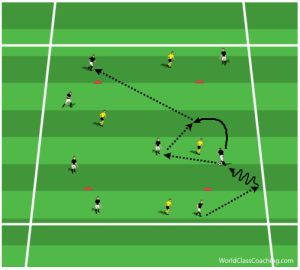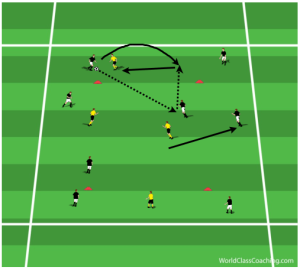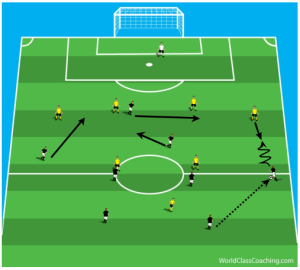By Sean Pearson
Session Length: 90 mins
During my days as a trainer, a lot of head coaches were (and still are) obsessed with the give and go, as if it’s the lifeblood of being a good team. While it is definitely a great combination to get behind opposition lines of defense it is not the be all and end all of attacking. Players and coaches alike need to understand it is a tool to use for specific scenarios to progress an attack, not to be used all the time as different scenarios will not allow it.
So to keep coaches happy and work on the give and go I developed a session that constantly worked on using the combination in the correct scenario and only using it when you should. Teaching the players about looking for the right placement of players for it to be successful and then transferring it into game scenarios.
Warm up/Technique: Time: 15 mins
Set up an area 40x30, place 2 cones each 10 yards from the touch line and 3 in the middle like the diagram. Partner your players up with one dribbling the ball and one supporting at an angle. The cones represent defenders.
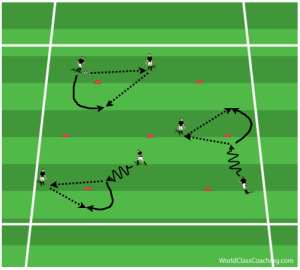
- Players dribble specifically towards the ‘defender’ so as to draw them towards them or ‘commit’ them in a game. This leaves space behind the defender.
- Their partner is ahead of the defender, at an angle to either side.
- 2 steps before the defender, the player with the ball, passes to their partner at an angle. One step would allow the defender to tackle/block the ball and three would allow more time for the defender to react and drop back to stop the second pass.
- Coach both passes, with the inside of the opposite foot and outside of the near foot.
- The combination is quick, that is why the receiver must play the ball one time, into the space ahead of the initial passer. Depending on body position this pass can be played a number of ways.
- After the first pass the dribbling player runs the opposite way around the defender to the ball. This is to restrict the defender to only being able to see either the ball or attacker.
- This player then receives the ball and continues their momentum forward.
- Remember this combination will not work if there is no space behind the defender.
Conditioned Game Time: 25 mins
Now pick up the middle 3 cones and you have an area with 3 zones. Two 10 yard end zones and a middle 20 yard area. This is to facilitate the amount of give and goes to a higher than normal occurrence during a game to give players repetition at executing the combination. Start with numbers up in all areas and tell the defenders they must press the ball. This is cheating a little but it is there to help your players see the scenario.
- Players stay in their allotted zones but the ball can move zones and players in different zones can combine for a give and go.
- To keep the ball moving tell players after a give and go they must pass the ball.
- Players spread out and when they see a 2v1 scenario the player on the ball dribbles towards the pressing defender and the second payer creates and angle of support.
- The forwards momentum from the dribbling player and the opposite momentum from the defender allows for more time and space for success.
Progression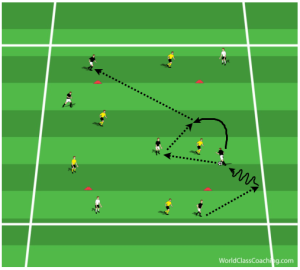
- Once players begin to understand the 2v1 scenario needed for success make the teams even.
- Do this by adding neutrals to each zone.
- Now 2v1 scenarios will be harder to come by and your players must see the ‘picture’ before they attempt the combination.
- This is when a give and go should NOT be considered.
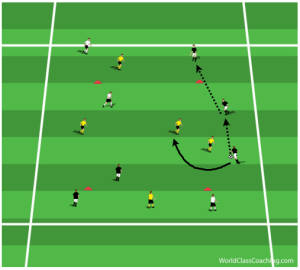
- There is a 2nd defender in the space where the 1st attacker would run into.
- Here the 2nd attacker, rather than attempt the combination, decides to pass to an open player instead, thus keeping the ball.
- To further progress this part of the practice have both teams play directionally, you can add goals or have target players to hit, whatever makes you desire.
Phase of Play: Give and Goes to Advance an Attack Time: 30 mins
Now we move on to a more game like scenario and discuss areas on the field where opportunities for give and goes are relevant to an attack. Remember the give and go is a tool to be used to progress up the field to eventually create a scoring opportunity, we do not simply teach our players to perform this combination because ‘it looks good’. Players must also understand where and when to use it.
- First aim to isolate the FB into, initially a 1v1 with the WM, by telling the WM to dribble at the FB to draw them out of position, or ‘commit’ them.
- Tell your ST to be inside the opposite CB, when the WM begins to drive at the FB to come across, in front of the other CB.
- This is so they are not static and easy to mark.
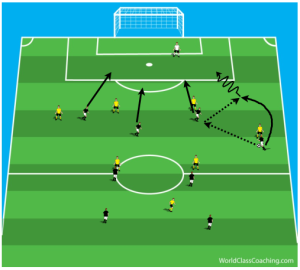
- The WM plays a give and go with the ST around the FB.
- After the ST passes into space, they spin the opposite side of the CB.
- The WM drives towards goal and decides to shoot or pass if players are in a better position to score.
[wpsharely id="2988"][/wpsharely]
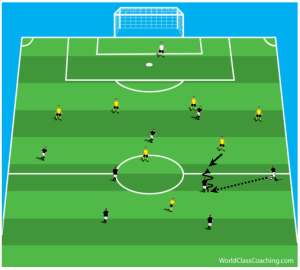
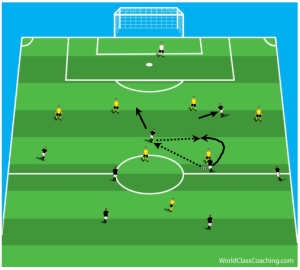
Option 2
- When the midfield begin to ‘cheat’ and stop the 1v1 down the side it is time to use the middle of the field.
- When a CM receives the ball, again isolate the opposing CM 1v1 and commit them.
- The AM should aim to be diagonally opposite between the lines of the opposition.
- The CM & AM play a give and go around the opposing CM.
- Both AM and ST make runs either side of the CB behind the CM.
- The CM commits the CB and slides a pass to either the AM or ST.
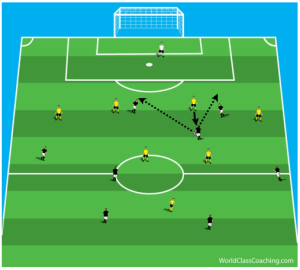 Scrimmage: Time: 20 mins
Scrimmage: Time: 20 mins
Remember it is imperative that when scrimmaging, players understand when and where to attempt a give and go and not to force the combination. There should be 2v1 scenario with space to exploit behind the defender. It should also be used as a tool to advance and attack or create an opportunity, not to simply achieve a give and go. The amount of give and go opportunities will naturally decrease but look for players to intelligently determine when the combination is possible.
By Sean Pearson Sean is also the author Coaching Team Shape in the 3-3-1, Coaching Team Shape in the 4-2-3-1 and Coaching Team Shape in the 4-3-3

